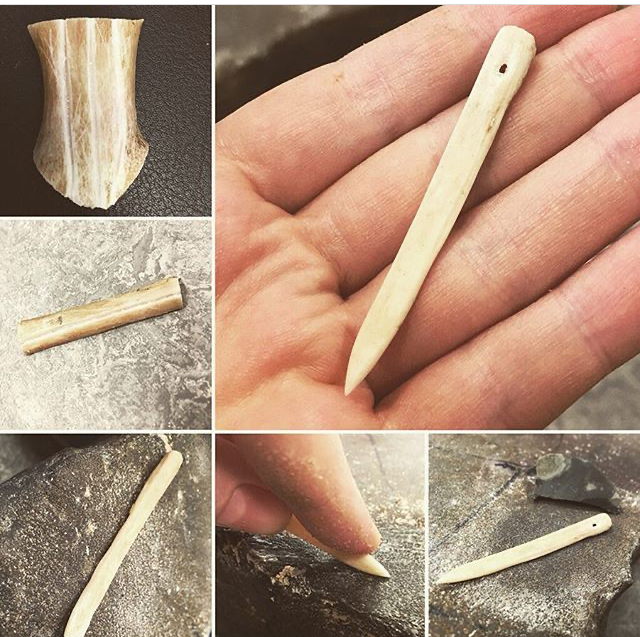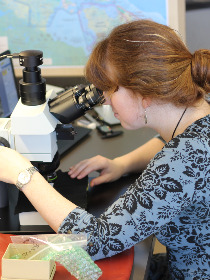Sewing with sealskin by Matilda Siebrecht

“Why is there fur on this chair?”
The question came at lunchtime, when someone sat down in the Arctic Centre dining room and noticed some fishy-looking hairs stuck to their chair. I averted my eyes and cleared my throat. The hairs were there because I had borrowed the chairs and set them up outside in the bicycle shed for a sewing workshop that morning. I know what you’re thinking – why do sewing workshops need to take place outside, surely they can be done inside? Perhaps, but I think my colleagues would have been complaining about more than a few rogue hairs if I’d brought in my collection of seal, caribou, and fox skins and allowed six students to sew them for a few hours.
To provide some context; my PhD project investigates organic material culture (ie artefacts made from bone, antler, and ivory) from Paleo-Inuit sites in Nunavut, Arctic Canada. My methodological focus is microwear analysis, which is the examination of microscopic traces of manufacture and use that are created on artefacts during their lifetime. My current sub-project is looking at sewing technology (i.e. needles) and more specifically trying to determine whether it is possible to identify what skin type Paleo-Inuit needles were used to sew based on the microscopic traces observed on their surface. In order to do this, I first had to do experimental archaeology (i.e. the replication of past objects and activities) to create a reference collection of needles with known traces. This meant that I could then compare the traces on my experimental needles with those on the archaeological collection, and (hopefully) infer from this what material the latter were used to sew. The results of this will provide all sorts of interesting information, including an insight into the skin-processing practices of different sites, the decisions made during needle-manufacture, and different methods of sewing in the past. I won’t go into too much detail, as the analysis is still ongoing, but there will be a paper coming out in the hopefully not too distant future, so do keep an eye out for that.
So going back to the hairy chair. In order to create a good reference collection, I needed to do a lot of sewing, using needles and skins from different species that were present in the Arctic during Paleo-Inuit settlement. This included needles made from ivory, caribou antler, caribou bone, duck bone, goose bone, and seal bone, and skins from caribou, seal, and fox (all both with and without fur and with different methods of tanning). It was, not to put it too fine a point on it, an epic project. And I was just one little PhD student with many other sub-projects to do.
Luckily, I happened to make contact with Jelke Take, a bachelor student who I was going on fieldwork with to Nunavut in summer 2019, and who happened to be a co-founder of the student association ‘WEAG’; the Workgroup of Experimental Archaeology in Groningen. After listening politely to me enthusing about my sewing project, he suggested that some of the WEAG members might be interested in helping out, in order to get some experience with an experimental archaeology project. I immediately jumped on the idea, and soon I had enlisted the help of five enthusiastic students; Lotte Zanting, Sandra Coenen, Wiske Bruinsma, Anne Vrielink, and Rhea Buijs, as well as Jelke himself. Over the course of the next two years, we would hold regular little sewing workshops, hunched over various skins in the bike shed outside the Arctic Centre or in the stairwell beside the back door, exchanging ideas and thoughts on the efficiency of different sewing techniques, and lamenting the occasional snap of a broken needle. Thanks to these wonderful students, I was able to create an excellent reference collection, which means that my project on Paleo-Inuit sewing technologies will have a very detailed dataset.
So the next time you visit the Arctic Centre and notice a rogue piece of fur attached to your chair, don’t worry. It’s probably just a bit of caribou that came loose during a particularly violent needle push.

Over de auteur

Matilda is a PhD candidate in Archaeology at the Arctic Centre. Her research focuses on Paleo-Inuit material culture from the Foxe Basin region, which she studies using microwear analysis to investigate how these objects were made and used in the past. In addition to her archaeological research, Matilda is a journalist and keen science communicator, and is involved in many digital outreach projects sharing archaeological knowledge with the general public.

